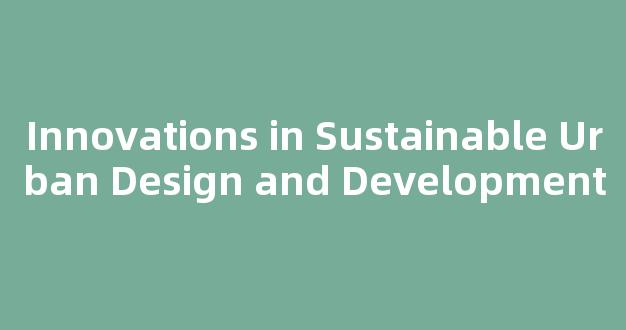Innovations in Sustainable Urban Design and Development
In today’s rapidly urbanizing world, the need for sustainable urban design and development has never been more critical. As cities grow at unprecedented rates, the challenges of climate change, resource depletion, and social inequality have become increasingly pressing. In response to these challenges, innovators and urban planners around the globe are coming up with creative solutions to build cities that are not only environmentally friendly but also socially inclusive and economically viable. This article explores some of the most exciting innovations in sustainable urban design and development that are shaping the cities of tomorrow.
The Rise of Green Infrastructure

One of the key trends in sustainable urban design is the rise of green infrastructure. Green roofs, vertical gardens, and urban forests are becoming increasingly common in cities around the world. These green spaces not only help reduce the urban heat island effect but also improve air quality, provide habitats for wildlife, and create recreational areas for residents. By integrating nature into the built environment, cities can mitigate the impacts of climate change and enhance the quality of life for their inhabitants.
Smart Technologies for Sustainable Cities
The advent of smart technologies is revolutionizing how cities are designed and managed. From sensor-equipped streetlights that adjust their brightness based on pedestrian activity to real-time data analytics that optimize waste collection routes, technology is being used to make cities more efficient and sustainable. Smart grids, autonomous vehicles, and energy-efficient buildings are just a few examples of how technology is being harnessed to create greener and more livable urban environments.
Community Engagement and Social Equity
Sustainable urban development is not just about environmental considerations; it also encompasses social equity and community well-being. Planners are increasingly recognizing the importance of involving local communities in the design and decision-making processes that affect their neighborhoods. By engaging residents in urban planning initiatives, cities can ensure that development projects are responsive to the needs and aspirations of the people who live there. This participatory approach not only fosters a sense of ownership and pride among residents but also leads to more equitable and inclusive cities.
In conclusion, the field of sustainable urban design and development is evolving rapidly, driven by a growing recognition of the need to create cities that are environmentally sustainable, socially equitable, and economically resilient. By embracing innovative solutions such as green infrastructure, smart technologies, and community engagement, cities can pave the way for a more sustainable future. Through collaboration and creativity, we can build cities that not only thrive in the present but also leave a positive legacy for generations to come.